The content of the article
After facing, tile laying inevitably leaves excess glue that needs to be removed. It is absolutely impossible to leave work in an unfinished state, because the adhesive base spoils the aesthetic appearance and distorts the surface characteristics. Depending on the degree and type of pollution, the problem can be dealt with using special or folk remedies. We highlight important aspects and give practical advice.
Types of glue base
Tiling is done using mixtures of various types and structures. This feature is determined by the rate of adhesion of the adhesive to the surface, durability and ease of use. It follows that the cleaning technology of tiles varies considerably depending on the base on which it is mounted.Consider the types of glue and their features.
- Cement base. It is a plastic mass, which is widely used for laying tiles. Due to its thick consistency, the composition ensures maximum adhesion of the tile to the surface. The hardness and quality of the cement base directly depends on the incoming additives that are interfered during the preparation process.
- Epoxy base. Glue of this type includes resinous compounds, due to which the mass slowly hardens. For this reason, epoxy is rarely used, moreover, it is difficult to remove from the tile surface. Usually for cleaning tile used special formulations that are sold in any hardware store.
- Polymer base. Like cement glue, polymer blends are quite widely used in the process of facing works. They are a gel-like or pasty mass that quickly sets and hardens. Acrylic is added to the composition of the product, as a result of which the composition for removal is selected individually (for cleaning tiles from acrylic (polymer) glue).
- Homemade base. In order to save on tile laying, many people prefer to prepare self-kneading.- homemade solution. As a rule, it consists of cement mixed with sand in certain proportions. If a large amount of sand is added to the composition, the mixture becomes brittle, as a result of which the quality of the installation suffers. The composition is cleaned off quite easily, for you it will be an undeniable advantage.
Important!
If a glue base is used for tile laying, which dries quickly, it must be removed immediately. Otherwise, after 2-3 hours, the composition will grab with the front surface, and it will be almost impossible to scrape it off.
Effective ways to clean tiles from glue
To remove the glue from the tile, it is necessary to approach the process taking into account the type of mortar used. Consider effective methods.
Liquid (fresh) glue
In the process of lining the surface, you must be extremely careful, but it is not always possible to keep the tile in its original form. Remains of glue appear through the seams, the base often falls on the already laid parts. In such situations, you need to immediately remove the tile glue, without waiting for the moment when it hardens.
- After laying each tile (piece), take a spatula with a rubber tip and walk around the perimeter of the fragment. Remove any glue residue from the seams if the base has reached the surface.
- After the protruding solution is removed, wash the spatula in warm water, then remove the smudges and drops on the tile surface with it.
- Dampen a clean rag in warm water, rinse each tile from which the glue has been removed. Take a dry cloth, wipe the tile dry, excluding the appearance of stains (water + adhesive base), evaluate the result.
In most cases, inexperienced handlers ignore such manipulations, which subsequently causes housewives to clutch at the head. It’s much easier to prevent a problem than to fix it later.
Frozen glue
As mentioned earlier, fresh glue is not always removed from the surface. The solution hardens, which greatly complicates the task. Start the procedure as soon as possible to increase the chances of a favorable outcome.
Remove the frozen base will not succeed with ordinary water and a rag. Prepare materials with high abrasiveness, a sponge and water in advance.Proceed to a hard cleaning, following the step-by-step instructions below.
- First of all, it is necessary to soften the glue stains with water, so that later it is easier to scrape them. You can also use an industrial solvent or composition for acrylic / polymer blends, if the glue does not react to water.
- After impregnating the base with a liquid or a special solution, proceed to the mechanical cleaning. Take a hard sponge, construction scraper, sandpaper of moderate abrasiveness, pedicure pumice, rub the surface. If the glue is frozen in small drops, scrape it with a glass nail file.
- After the top layers of glue have been successfully removed, re-soften the base in a convenient way (water, solvent, etc.). Repeat the previous manipulations, scraping the glue mechanically. Proceed step by step: softened, scraped, softened again. Try not to damage the face of the tile.
- After removing the main part, change the tools more gentle. Take a melamine sponge, an old toothbrush, a hard rag, or a microfiber cloth.Apply gel remover or ordinary solvent on the tile surface, walk on the surface, finally removing the excess.
Important!
Do not attempt to scrape off glue with a knife, blade or other sharp tool. You risk damaging tiles, splitting one or more pieces.
Cleaning tiles with special tools
It is important to understand that tile adhesive is not always possible to remove using the methods described above. For such purposes, you can purchase special tools that greatly facilitate the task. Thanks to the active ingredients in the product, glue spots are corroded.
- Choose a remover for glue, taking into account the solution used (cement, epoxy, polymer, etc.).
- Purchased products can dissolve the glue completely or soften it partially. In the second case, the cleaning is performed as described above mechanically.
- When choosing the composition, pay attention to the structure of the tile, not every tile tolerates the effects of hard preparations.
- Protect the airways, skin of the hands and eyes before use. Do not inhale volatile fumes.
- If the adhesive base is removed from the surface of the tile after grouting, do not allow the composition to get into the slots. Otherwise, the grout may change color or dissolve.
- Before paying money for a particular drug, carefully read the label on the back of the bottle. Make sure that the composition and appointment is appropriate for the task.
Cleaning tiles by folk methods
Remove cement, homemade or polymer base can be folk remedies in the event that the composition is partially frozen. Consider effective recipes in order.
- Lemon acid. Dissolve 55 gr. acid in 1 l. boiling water, stir to dissolve the crystals, cool to a warm state. Dampen cotton cloth in the solution, walk on the surface of the tile, wipe dry.
- Drinking soda. Prepare the porridge: dilute the soda with cool water so that a pasty mass is obtained. Scoop the compound on the sponge, handle the frozen areas of glue. Wipe the tiles with a damp cloth and dry.
- Bleach. Purchase a "Whiteness" or other similar product at the hardware store. Put on gloves, dilute 1 cap in 2 l.water mix. Moisten a hard cloth, wipe the dried adhesive base.
- Vinegar. Protect skin of hands, moisten a sponge in table vinegar with concentration of 9%. Well rub the remnants of glue, scrape it mechanically. If necessary, perform the procedure several times.
To remove the tile from traces of glue, you can use special tools or household formulations. If the solution cannot be removed, soften it and remove it mechanically (sandpaper, pumice stone, scraper, etc.). If possible, prevent similar effects by cleaning the protruding glue immediately after laying the tile.
Video: how to clean tile from glue and grout

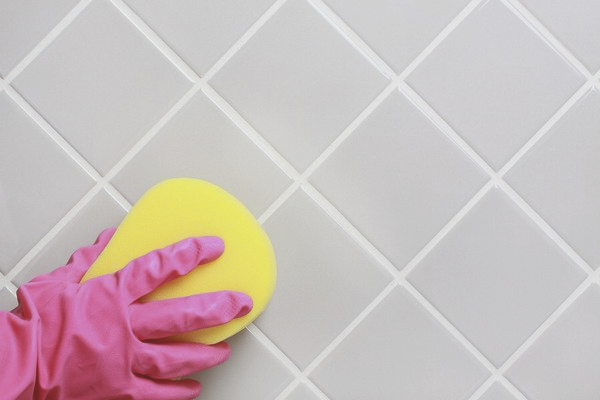
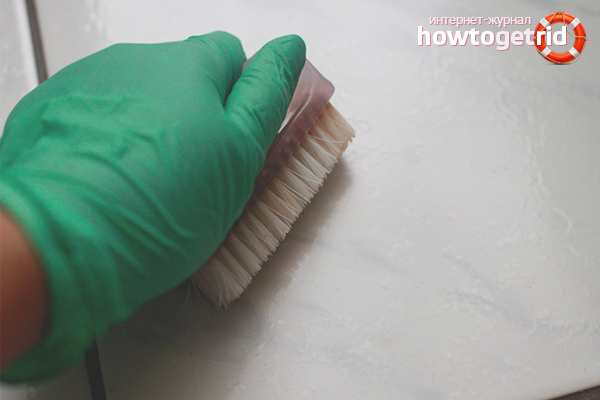
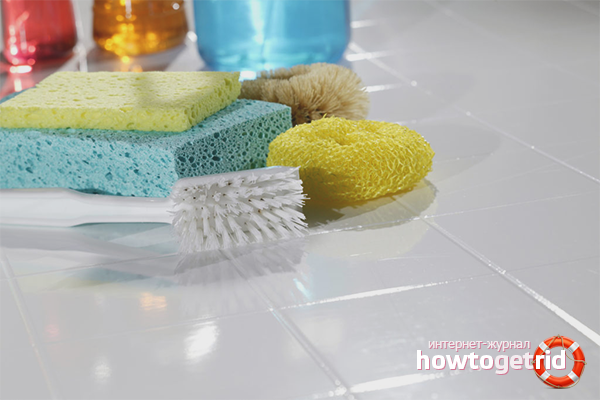

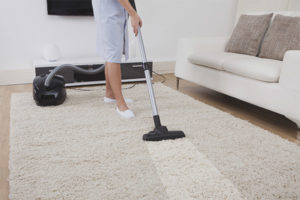

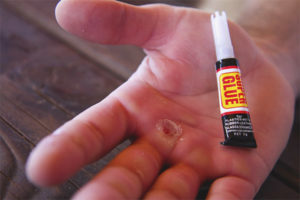
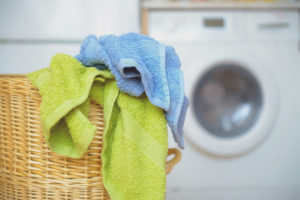
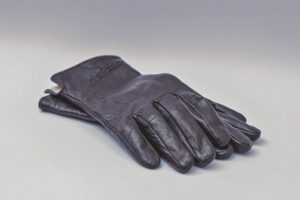


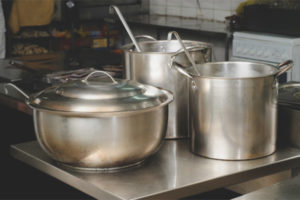
To send